The recovery of heat from power generation in Scotland: study
This study examines the technical and financial prospects for recovery of heat from four sites used for large scale fossil fuel power generation and then explores policies that could help make the recovery of heat a more practical option.
3 Network Modelling
3.1 Energy Supply
Recovery of heat from power stations requires investigation of the heat available along with identification of the potential heat consumers. This section looks at the energy supply and reviews the scale and performance assumptions for the four power station sites.
3.1.1 Site Selection
Conventional power generation produces large amounts of heat which needs to be dispersed into the environment. In Scotland all large conventional power stations are located on the coast, where seawater is used as the cooling medium.
The amount of heat produced is significant; a large coal fired station will be around 40% efficient, a large gas station will be around 50% efficient. Hence, up to 60% of the energy in the fuel will be discharged to sea via the power station's cooling systems or lost through the flue (chimney). The output of the current conventional power stations range from 1,150 MW e to 2,400 MW e, so significant quantities of heat are available.
Heat is also produced by smaller biomass stations; several such stations are in operation, whilst several more are proposed. The stations currently in operation all recover some heat. Work is underway to examine the potential for heat recovery as part of the Section 36 planning applications for the proposed stations. All of the biomass stations and proposed stations are significantly smaller (36 MW e to 200 MW e) than the conventional fossil fuel stations; as such these will produce less heat.
This study focuses on heat recovery from the four fossil power stations in Scotland - as these offer greater amounts of available heat and little work on heat recovery has been undertaken to date. Three of these fossil stations exist, one is in planning. A high level study has been undertaken to estimate the potential heat loads for the proposed Hunterston plant. This study looks in detail at potential heat loads and the financial attractiveness of connecting some or all of these.
Table 2 Power station operation and capacity
| Station | Summary |
|---|---|
| Cockenzie | Currently a 1,150 MW e coal fired power station. Due to close prior to 2015 as the station has opted out of the Large Combustion Plant Directive ( LCDP). Planning application submitted for a gas fired replacement of 1,200 MW e. Closest of the 4 sites to a major conurbation. |
| Longannet | Currently a 2,400 MW e coal fired power station. Opted in to LCPD. Flue Gas Desulphurisation ( FGD) being fitted and consent granted to fit Selective Catalytic Reduction ( SCR). Expected to operate for some years. |
| Peterhead | Currently a 2,177 MW e gas fired power station following recent upgrades in 2000 and again in 2007. Transmission system limits the output to 1,550 MW e. Hence there are proposals to reduce capacity at Peterhead. |
| Hunterston | Proposal for a 1,852 MW e multi fuel (coal and biomass) station. Planning application submitted. Application includes a heat recovery study considering potential use of heat with 20 km. |
3.1.2 Assumptions regarding the four power stations
Heat from Power Stations
Power stations are designed to maximise electrical efficiency, making the best use of the fuel purchased. Some heat is rejected into the seawater cooling systems, but this is at a low temperature. This is a lower temperature than used by heat consumers, so is unsuitable for heat recovery.
Instead heat needs to be extracted from a steam turbine. All of the four stations have steam turbines, either as the main prime mover (Longannet & Hunterston) or as part of a combined cycle system (Cockenzie and Peterhead).
Loss of Electricity Generation
In each of the four power stations, heat would be extracted from the steam turbine at a pressure suited to the scale of heat demand. The steam needed for the heat network is extracted before it reaches the final stages of the steam turbine. Therefore, a reduction in electricity generation occurs as the steam extracted does not contribute fully to the electricity output of the turbine.
The amount of electricity generation foregone depends on the amount of steam extracted and the pressure that remains in this steam. This is known as the Z factor.
For these four stations the majority of heat demand will be for hot water based heating, typically generated by conventional boilers at 80°C, returning at 70 C. It is assumed steam would be bled from the power stations between the final two stages of the steam turbines where the steam will be at the lowest useful temperature and pressure. This is typically at 2.4 bar, to feed hot water networks via heat exchangers. The corresponding Z factor at this steam bleed pressure is 6.3 [6] .
This means that for every 6.3 units of thermal energy extracted as steam, the electrical output will be reduced by 1 unit. So a 1,000 MWe station operating at full output and extracting 63 MW of steam will actually generate 990 MWe.
If heat can be recovered at a lower pressure the Z factor would be lower, with lower reductions in electricity generation. But extracting heat at a lower pressure may limit the efficient transfer of heat into the district heating system. If the district heating system requires higher pressure steam, e.g. for industry, the Z factor will be lower with higher losses of electricity generation.
Power and heat output
As the preceding section shows, there are proposals that could alter the existing or proposed capacity and operating mode of each of these four stations. Therefore we have been conservative in estimating the amount of heat available, we have assumed lower capacity at each site, as shown in the following table:
Table 3 Assumptions regarding the 4 power stations
| Station | Modelled Capacity and assumptions regarding fuel mix and efficiency |
|---|---|
| Cockenzie | 1,000 MWe, 100% natural gas input, fully condensing gross electrical efficiency 50% Gross Calorific Value ( GCV) |
| Longannet | 1,200 MWe, 100% coal input, fully condensing gross electrical efficiency 40% ( GCV) |
| Peterhead | 1,000 MWe, 100% natural gas input, fully condensing gross electrical efficiency 45% ( GCV) |
| Hunterston | 1,200 MWe, 90% coal gross energy input, 10% biomass gross energy input, fully condensing gross electrical efficiency 40% ( GCV) |
These assumptions require some detailed explanation:
Peterhead is a steam turbine driven by both the original steam boilers and a later gas turbine. Hence we have assumed that the efficiency at Peterhead is 45% rather than the 50% assumed for the proposed Cockenzie station which is a modern Combined Cycle Gas turbine ( CCGT).
The proposed station for Hunterston is co-fired and will therefore earn income from Renewables Obligation Certificates ( ROCs). Extracting steam to recover heat will reduce electricity output - some of which would have earned ROCs. To calculate this requires details of the proportion of input fuels biomass vs. coal. The Hunterston feasibility report states that the plant will be designed to allow up to 14% of input as biomass but currently power stations typically only co-fire around 3% [7] so based on experience to date, a 10% estimate is used, which is conservative in terms of potential loss of ROCs.
Interaction with Carbon Capture and Storage
Carbon Capture and storage ( CCS) is likely to play an important role in reducing CO 2 emissions from fossil fuel power generation and industrial plants. Amongst the several methods available for capturing CO 2 from large stationary sources ( e.g. power plants) amine-based post combustion capture is the leading contender as it can be fitted to existing and new power plants. However, the amine capture process requires significant amounts of heat for regenerating the solvent before it is recycled to absorber for further CO 2 separation.
The heat required could be provided by extracting steam from the steam turbine in the power generation cycle. Hence district heating and amine-based post-combustion capture systems are competing demands for the heat available from the steam turbine. The study undertook a high level review of the compatibility of district heating with CCS - will sufficient heat be available?
This high level review compared the heat available from the steam turbine at each site with the heat demands for CO 2 capture and district heating at that site. It was concluded that there is likely to be sufficient steam available to cover both the district heating and solvent regeneration demands for all sites.
The most challenging example is the Cockenzie. This site has the largest heat load and hence the highest peak heat demand. As the power station is a CCGT, the steam turbine has less heat available than from a coal fired station. The review showed that even with 100% of the heat loads connected, this station should be able to serve both the district heating system and the CO 2 capture process.
Comments from Scottish Power suggest that it could be possible to recover some of the heat that is used in the CO 2 capture process for use in district heating, adding an extra margin to the heat supply available. For example, heat is available from the re-boiler condensate at an ideal temperature for district heating (120-130 °C). Additional heat can also be recovered from the CO 2 compression plant and this can either be used for solvent regeneration or directly in the DH system.
Capital Costs
Although the Longannet and Peterhead plants are in existence and the proposed Cockenzie upgrade will have some of the necessary electrical infrastructure in place, they are modelled as if they are to be built from new. This helps inform policy relevant to new power stations.
The assumed capital costs for the basic power plant are estimated at £1,500/ kWe for coal and co-fired fired stations and £720/ kWe for gas-fired stations and the estimated additional cost (excluding district heating pipe work) of making these capable of heat recovery is estimated at 1.5% of this basic capital cost.
It is assumed each station will run at full capacity for 7,000 hours/yr i.e. in fully condensing mode the 1 GWe stations will generate 7,000 GWhe/ yr and in heat recovery mode will consume the same amount of fuel but generate less power due to heat extraction. Hence the investment case for the new power station assumes a high utilisation factor.
It is assumed that the power stations will last at least 40 years and the annual operating and maintenance costs over the life of the plant will be 5% of the capital costs throughout the life of the plant for coal stations and 2.5% for CCGT. This may be somewhat conservative for the coal fired power stations but it will not affect the financial assessment of connecting to district heating as this will not affect the maintenance costs.
3.1.3 Backup Heat Supply
Large scale power stations increasingly operate in a flexible manner. This reflects the:
- Dynamic pricing that exists within the GB electricity market, which offers higher income to flexible plant.
- Increasing capacity of wind on the network, which requires other plant to be available to operate.
When not generating energy, large fossil power stations need to be available to operate. The main thermal items of plant are always kept warm, ready to operate when market conditions make this attractive. Hence, fuel will continue to be consumed to ensure that the station is ready.
Keeping the station warm reduces maintenance costs and maintains efficiency as it avoids thermal cycling of key plant items. Thermal cycling reduces plant life as repeated expansion and contraction of steam pipes leads to fatigue and cracking. Cracks in steam pipes reduce efficiency as steam escapes, whilst fixing cracks requires downtime to identify and repair. Both of these aspects add cost. Hence, we assume that sufficient heat will be available from these stations at all times without any significant change to their capital cost. However, they may at times be required to burn more fuel to provide heat, so operating costs may increase slightly.
The proposals for Electricity Market Reform (discussed in section 7.2) include a capacity payment, a new form of revenue to reward stations for being available to run. This proposal further supports the year round availability of heat from large fossil stations.
We have also modelled a separate case where the owner of the power station and the owner of the district heating are different commercial entities. In this case it is assumed that the owner of the district heating system owns and operates a heat only gas boiler to provide back up heat.
3.2 Energy Demand
In order to assess the potential for heat recovery all possible heat loads must be identified. The scale and location of each heat load is important as capital costs are high and so critical to the cost of heat supply and the financial returns. The specification for this study included a 30 km catchment area which would ensure that all possible heat consumers were considered.
The focus of this assessment is on anchor heat loads. These are heat consumers that will be commercially more attractive for heat supply.
3.2.1 Anchor Heat Loads
The factors that make certain heat consumers attractive include:
- Scale - customers with high heat loads are more likely to be worth the capital costs.
- Consistency of heat demand - heat sales are needed all year round, so customers with significant summer heat demand are valued.
- Longevity - district heating is a long term asset which requires customers to be connected over many years. Public sector customers tend to have longer term predictability over the pattern and longevity of site use and site heat demand.
- Credit risk - to raise capital for a long term asset, investors in district heating need assurances that potential heat consumers are able to pay for their heat over the long term. Public sector heat consumers have the lowest credit risk.
- Driving factors - district heating is not widely known in Scotland. Hence heat customers will need persuasion to connect. Driving factors will include; lower costs of heat, and policy factors such as avoiding Carbon Reduction Commitment ( CRC) charges or meeting targets on carbon emissions. These driving factors will be greatest for public sector customers, as all Scottish public bodies are required to act to meet the targets in the Climate Change (Scotland) Act 2009.
The following table shows how these factors are scored against a number of potential heat customers, leading to the selection of key anchor heat loads.
Table 4 Selection of Key Anchor Heat Loads
| Scale of Heat Load | Consistency of heat demand | Longevity | Credit risk | Driving factors | |
|---|---|---|---|---|---|
| Hospitals | Large | High | Long | Low | CC Act Duties HEAT targets CRC |
| Schools | Medium to Large | Medium | Long | Low | CC Act Duties CRC |
| Prisons | Large | High | Long | Low | CC Act Duties CRC |
| Swimming pools | Medium to Large | High | Long | Low | CC Act Duties CRC |
| Process Industry | Medium to Large | Medium | Medium | Medium | CRC |
| Offices, Retail | Small to Medium | Low | Medium | Medium | CRC |
| Individual Homes | Very Small | Low | Short | High | Minimal |
| Social Housing | Medium | Low | Short | Medium | Low |
| New Housing Developments | Medium | Low | Medium | Low | Planning |
| New Business Developments | Medium | Low | Medium | Medium | Planning |
Hence the most attractive consumers will be large public sector buildings with year round heat demand, examples include; hospitals, prisons and publicly owned swimming pools.
The least attractive will be small private-sector buildings with seasonal heat demands. Examples include; offices, retail outlets and individual homes.
Hence, our identification and analysis of heat demand focuses on those anchor heat loads that are more attractive:
- Hospitals;
- Schools;
- Prisons;
- Swimming pools;
- Universities and colleges;
- Industry and commercial sites;
- Large new housing developments; and
- Large new business development sites.
3.2.2 Existing Housing
As explained in the previous section, this study has focused on large new housing developments and has not considered the potential to retrofit district heating to existing housing. There are several reasons for this.
From a technical standpoint individual existing homes are not anchor heat loads:
- They are very small heat loads and hence offer small amounts of heat sales income.
- They have highly seasonal heat demand, adding to the peak heat demand and hence cost of the district heating network.
- They will require existing boiler systems to be removed and replaced with district heating consumer interface units. The space and location of the existing boiler may not be well suited to conversion.
- They may currently use electric heating. Replacing electric heating with recovered heat will offer much higher CO 2 savings. However the capital costs will also be much higher, to cover removal of the electric system and installation of radiators, pipes and controls. So the added benefit is balanced by a significantly higher cost.
From a financial standpoint:
- When calculating the cost of connecting a new home to district heating we can take into account the costs avoided by not having a boiler. This makes connection of new homes more cost effective than retrofitting existing properties. The study uses an assumed connection cost of £3,800 per dwelling. This is taken from the PB Power study for the Scottish Government which uses data from the International Energy Agency [8] . The assumed cost of a conventional boiler is £2,525, giving a net cost for new dwellings of £1,275. This is clearly much higher than the retrofit cost of £3,800.
- As a long term investment, district heating operators prefer to have long term heat supply contracts. Public sector clients can enter this type of contract, while individual homeowners are not likely to sign up to long term arrangements.
- The cost of extending the main pipe to an individual home will be very high in relation to the income in heat sales from that property. Hence retrofitting would be most cost effective if groups of individual homes were connected at the same time.
- Groups of homes in common ownership, e.g. council or housing association offer better opportunities as the income is greater and the costs of connection will be lower and long term contacts could be arranged.
From a policy standpoint:
- Planning policy and the requirements to co-locate heat supply and demand and to reduce carbon emissions act as lever to connect new housing developments. There is no equivalent lever for existing housing.
Practical considerations:
- Development plans provide a ready source of data on the location and scale of proposed housing developments. To consider existing housing, would require data on individual dwellings or for the social landlords, groups of dwellings under the same tenure. This data is not as readily available.
None of the above precludes the connection of individual existing homes to a district heating scheme. However, the business case for district heating schemes focuses on larger anchor heat loads as the core market. This approach can be seen in most examples of UK district heating scheme development, e.g. Southampton, Nottingham, Citgen in London and a number of schemes designed for new developments e.g. Glenshellach in Oban, the Home Farm Biomass Community Heating on Skye and the Hill of Banchory district heating Scheme in Aberdeenshire. Once the main system was installed some individual homes have connected, e.g. if the district heating main is already passing the property. A study by Poyry [9] notes that district heating operators in Finland set high connection fees for individual homes, to reflect the high costs and low income for these customers.
There are some exceptions to this, for example the Shetland District Heating Scheme. This includes many individual dwellings as customers. Some of the factors that led to the development of the Lerwick scheme are unique, including:
- The need for a practical and economic solution to deal with waste arisings on Shetland.
- Capital availability from the Shetland Oil Fund.
- Very high heating energy costs for homes.
- Grant support for connection of homes.
Hence the overall business case, and costs and benefits of connecting individual homes, is very different in this case.
3.3 Approach to Heat Maps and Anchor Loads
For the purpose of this assessment, the analysis focused on identifying heat loads in locations within the 30 km catchment around each station. The following map shows the location of the sites and the 30 km radius around each of these sites.
Figure 2 Study areas
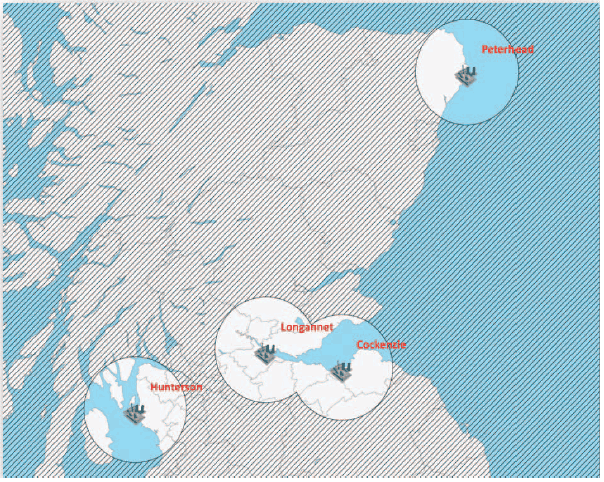
There are areas within the 30 km radius that are impractical for heat recovery, examples include:
- Hunterston; Crossing the Firth of Clyde to serve heat loads on Arran, Bute, Cowal etc.
- Cockenzie: Crossing the Firth of Forth to serve heat loads in Fife.
Hence, some areas within the 30 km radius were not searched for suitable anchor heat loads.
GIS maps were developed to show anchor heat loads as separate data layers, with details of peak heat demand (which determines the size of the heat pipe), the annual heat demand (which determines the income from heat sales) and the location (which determines the length of pipe run needed and hence the capital cost).
In most cases, the information about the location of each anchor load has been provided to a full post code resolution. These enable both the geographic location and the magnitude of the heat load to be well characterised. In other cases, the level of evidence was available in a lower resolution ( i.e. Local Authority level) and therefore, different assumptions were made.
Figure 3 briefly describes the approach taken to produce the heat maps.
Figure 3 Steps to develop the anchor heat load maps
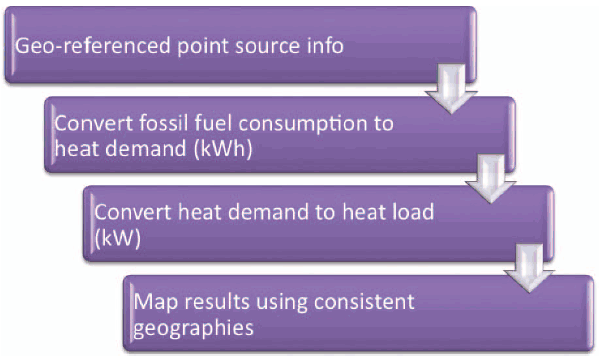
The mapping methods and data used to develop these distributions are explained in the following sections.
3.4 Data used for Anchor Heat Loads
Individual buildings or groups of buildings (where anchor loads have been estimated) and the distance between these buildings from the power stations was accurately determined using the electronic OS MasterMap [10] data provided by the Scottish Government and our Geographical Information System ( GIS). An extension of the OS MasterMap, the OSITN layer [11] was also used in order to identify the road transport network links to a very high resolution.
All maps in this document are reproduced from Ordnance Survey material with permission of the Controller of Her Majesty's Stationery Office Crown Copyright. Unauthorised reproduction infringes Crown copyright and may lead to prosecution or civil proceedings. Scottish Government, Licence Number 100020540.
In order to compile the heat load map, assumptions for boiler efficiency and load hours were made; these are presented in Table 5.
Table 5 Assumptions for boiler efficiency, load hours & heat load
| Anchor sectors | Boiler Efficiency | Load Hours |
|---|---|---|
| Hospitals | 75% | 5,700 |
| Schools | 75% | 1,560 |
| Prisons | 75% | 2,950 |
| Swimming pools | 75% | 5,304 |
| Universities and Colleges | 75% | 2,950 |
3.4.1 Hospitals
As highlighted earlier, hospitals are a very attractive heat load. The sites are large, use space heating for most of the year and have strong drivers to improve energy efficiency and reduce carbon emissions. A detailed list of hospitals, their actual energy use and locations was provided by Health Facilities Scotland, using data from the NHSeMART system. These have been mapped in detail, as shown below for central Edinburgh:
Figure 4 Hospitals in Edinburgh
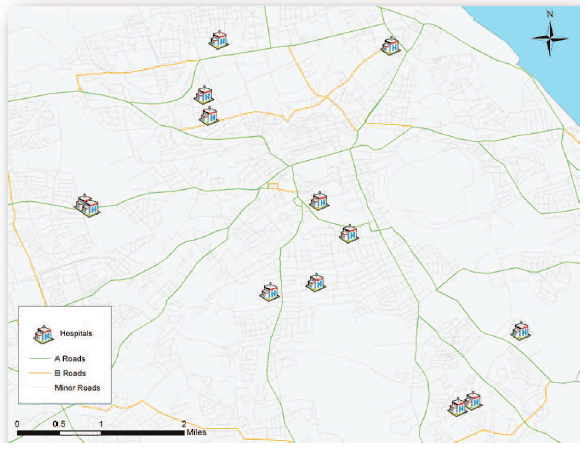
3.4.2 Schools
Schools are potentially attractive anchor heat loads, due to the public sector ownership and longevity of site use. The driving factors are also high due to public sector targets and the CRC. However, heat use in schools is seasonal and for smaller primary schools the heat use can be modest in scale. So these are less attractive anchor heat loads than hospitals, but secondary schools and larger primary schools may be important.
Two main sources of data have been used to identify the heat load from schools:
1. List of schools in Scotland in 2007 [12] .
2. The utility data from the "School Estate Statistics 2010" (published by Scottish Government.
The first source provides a detailed list of secondary and primary schools across Scotland, including post code location. This does not include heat use or the size of the school buildings. However, the data does include numbers of teachers.
The second source provides estimates for total energy used in schools in each local authority area.
The heat at each school was estimated using a series of modelling processes developed by AEA for the UK heat map. This uses employment statistics as a proxy for heat use at each site, hence using the details of teacher numbers from source one. The total heat use in schools for each local authority was calculated and cross checked with source two.
The following figure, (Figure 5) shows as an example the mapping of schools in central Edinburgh.
Figure 5 Example of the schools mapping (Edinburgh)
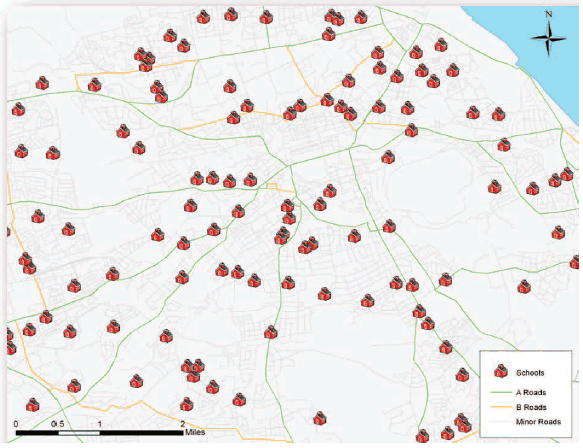
3.4.3 Prisons
Prisons are a very attractive heat load. The sites are large, use space heating for most of the year and have strong drivers to improve energy efficiency and reduce carbon emissions. The number of prisons is relatively small; hence these are less likely to be within the 30 km catchment of the four power station sites. However, one example, Peterhead prison is very close to the power station site.
The fossil fuel monthly consumption data, along with daily gas consumption data for prisons within the area of study has been provided by the Scottish Prison Service ( SPS) [13] . The postcodes of the prisons were obtained from SPS's web site.
3.4.4 Swimming Pools
Swimming pools are a very attractive heat load. The sites use significant amounts of heat throughout the year. Many large pools are owned and operated by the public hence there are strong drivers to improve energy efficiency and reduce carbon emissions.
Contact was made with Scottish Government and with Swimming Scotland to obtain a list of swimming pools in Scotland. No such list was found during the research. Most large swimming pools are run by local authorities. Hence, a search was made of the web sites of each local authority within the catchment areas of the four stations.
From this a list of swimming pool sites was built, with site name and postcode as the key data, along with information on the size of the pool (if stated on the relevant web site).
The heat use was estimated using UK benchmark data on the energy used in leisure centres with swimming pools. This was cross checked with data on a small sample of pools that was already held by AEA. This showed a conservative agreement between the estimate and the sample.
Hence this method was used across the full list of pools.
This method will not pick up other pools e.g. in hotels or gyms. Most of these will be small with lower levels of heat demand and the drivers for connection will be much weaker.
3.4.5 Universities and Colleges
Universities and colleges are potentially attractive heat loads. However, this sector is very diverse, ranging from colleges with a single building to universities with one or more multi-building campuses. Heat use for some will be significant and in others it will be much more modest. However the driving factors are strong, a range of policy initiatives influence this sector as well as student opinion.
The heat load estimates from universities and colleges, has been obtained from the UK Heat Map [14] . This dataset uses a series of modelling processes which has been developed by AEA, in order to estimate energy used from different sectors. Fossil fuel consumption is estimated using employment statistics in universities and colleges as a proxy for heat use.
3.4.6 Industry & commerce
Industrial sites are potentially attractive heat loads. Some sites are very large consumers of heat and often use heat year round. The drivers for connection can be strong particularly for sites in the European Union Emissions Trading Scheme ( EU- ETS) or CRC; however the duties on public sector bodies do not apply. In terms of longevity and credit risk industrial and commercial sites are less attractive than public sector sites.
From a technical standpoint there may be some more complex issues. Industrial sites with large and year round heat demand often already have their own dedicated CHP, e.g. paper mills, food sites etc. Hence the logic for connection will be weaker or absent.
Some industrial sites use steam as a heat carrier to serve the higher temperature processes on site. Hence, a district heating scheme would need to provide these customers with steam not hot water. This would alter some of the characteristics of the part of the district heating network that served these loads.
The large point source heat load sources used within the maps are available in the UK Heat Map. The detailed data on individual large consumers of fuel in the industrial and commercial sector is obtained from several sources:
- The Environment Agency's Pollution Inventory ( PI) & EU Emissions Trading Scheme ( EU- ETS).
- The Scottish Environmental Protection Agency's ( SEPA) European Pollutant Emission Register ( EPER) submission.
- National Atmospheric Emission Inventory ( NAEI) data.
- Data from the Department for Energy and Climate Change's ( DECC's) Combined Heat and Power Quality Assurance Programme ( CHPQA).
3.5 Future Anchor Heat Loads
3.5.1 Development Plans
Development plans were examined to identify if any proposed developments would be of a size or geographical location that they could be potential anchor heat loads. As noted previously, the actual heat loads for these sites can only be estimated as the details of the actual development cannot be predicted with certainty.
Business, housing and community development plan allocations (adopted or proposed), within a 30 km radius of each power station (Longannet, Hunterston, Cockenzie and Peterhead) were reviewed and thresholds were used to determine relevant sites, these were:
- Housing, over 100 homes (if two adjacent smaller housing sites were found to have an aggregate of 100 homes, these were included).
- Business, over 1 hectare.
- Community and school, all new sites except extensions.
The development plans reviewed were:
- Aberdeenshire;
- Clac kmannanshire;
- East Lothian;
- Edinburgh;
- Mid Lothian;
- Fife; and
- North Ayrshire.
Once identified, the list of developments was then verified using information received from the planning officers at each local authority. Some developments were found to differ in size (number of houses, hectares) while others were not within the 30 km boundary. In some cases the developments were no longer proposed to go ahead. These developments were removed from the list.
There will also be potential for new developments to be connected to a district heating network. New developments require planning consent and new planning guidance requires developers to consider how to reduce the carbon emissions associated with new housing, new business space and new community buildings. This provides an extra driver for new development sites. In this report, a separate section examines the size and location of new development sites. However, the actual level of heat load for a new development cannot be known with certainly and in some cases the sites identified for development may not actually be developed.
3.5.2 Longer Term Developments
The lifetime of the district heating schemes is assumed to be 40 years. Over this long timeframe there will be many new developments with housing, business and community buildings within each catchment area. This study uses data from the current development plans only, as these provide the location and scale details necessary for the analysis. However it is important to note that current development plans focus on the short to medium term, so it is highly likely that additional development will take place within the 40 years. It is not possible to include these opportunities in the assessment since there is no data on the location or scale of this development to be able to quantify the impact of this on the results. The results will be slightly pessimistic, as long term new development would add heat sales and improve investment returns. This effect may be modest, as the discounting cash flow calculations mean that the net increase in income will be modest.
3.5.3 Social Housing Customers
To attract customers the heat tariff offered by a district heating scheme operator will need to be lower than the cost of conventional suppliers of heat. This logic applies to all types of consumer, public sector, commercial and householders. Reducing heat costs is an advantage in all sectors of the economy. However for householders there is a further policy advantage, reducing the numbers of households in fuel poverty. This is a potentially important advantage, but realising this is likely to require intervention, as households in fuel poverty may not be the target market for district heating developers.
As discussed in 3.2.2 the study focuses on new housing, for a range of technical, financial, policy and practical reasons. However there will be opportunities to connect to social housing within the new housing developments that are included in the study.
Housing developers are encouraged to provide affordable housing within their plans. Scottish Planning Policy states that authorities may seek a percentage of affordable housing contribution from developers of new housing developments where this is justified by the 'Housing Need and Demand Assessment' and included in the 'Local Housing Strategy and Development Plan'. The benchmark figure is that each site should contribute 25% of the total number of housing units as affordable housing.
Housing developers can collaborate with a Registered Social Landlord to administer the affordable housing elements of their development.
Hence social housing will be included in the properties that are assumed to be connected to each of the four power station networks. However it is not possible to quantify or identify how many and where these homes will be - as this is a site by site issue that is negotiated in each case.
3.6 Logic Used to Select Routes for Pipes
The route mapping tool, Network Analyst (within Arc GIS), was used to create the most financially attractive route connecting heat loads together. This is the shortest distance to the power station along the road network.
The initial analysis included every existing and future anchor heat loads and initially this created some very large district heating networks. Further screening was needed to remove unviable heat loads. The following figure (Figure 6) shows, as an example, the initial main routes identified for Peterhead:
Figure 6 Example map to show the initial network route (Peterhead)
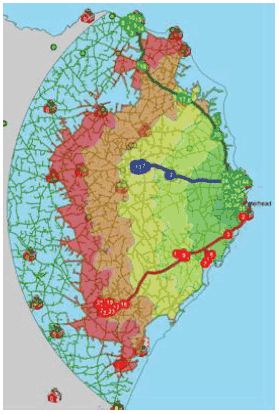
Green Route
This northern route has a total pipe length of 47 km, longest continuous length of about 36 km to Fraserburgh and along the way this section covers a heat load of approximately 70,000 kW (plus several areas of unknown heat load).
Blue Route
This central route has a total pipe length of 16.2 km, longest continuous length of about 12.5 km to Mintlaw and along the way this section covers a heat load of approximately 6,000 kW.
Red Route
This southern route has a total pipe length of 29 km, the longest continuous length of about 24 km to Ellon and along the way this section covers a heat load of approximately 16,000 kW.
Overall
MWth. Currently the largest network in the UK is 96 km in Nottingham.
3.7 Screening Tool
Details of potential anchor heat loads are included in the GIS map for each site. For each power station site there are many potential anchor heat loads. Many of these are small heat loads, of which some are a considerable distance from the power station site.
To be financially viable district heating systems should focus on supplying heat to core heat loads, where the high capital costs of the heat pipe are justified by the scale of the heat load served. Hence, many of the loads within the map will not be viable to supply even with policy support measures in place.
A screening tool has been developed to identify those heat loads which are credible for inclusion in the network. This helps to focus the analysis on those heat loads that can make a contribution to the financial returns of each district heating network.
The screening tool takes into account three key parameters:
- Peak heat load (in kW).
- Distance from the power station.
- Type of buildings being served.
Figure 7 Chart to show the screening of heat loads
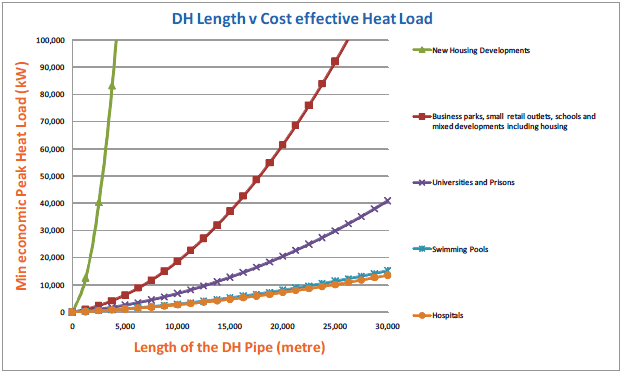
The lines were calculated using:
- Cost per metre for different district heat pipe sizes from a report by PB Power [15] .
- A discount rate of 9%.
- Projected heat price to end-consumer ( e.g. 3.36p/ kWh in 2013) derived from DECC gas and oil retail price projections (see section on key financial variables).
- DECC projection of wholesale electricity prices ( e.g. 6.63p/ kWh in 2013).
- Steam extracted at 2.4 bar.
- Ratio of heat extracted to power loss = 6.3 [16] .
- Assumed heating load factors i.e. average/peak heat load ratio.
- Additional distribution and connection costs for new housing developments of £1,300 per dwelling (£3,800 per dwelling less avoided £2,500/dwelling cost for conventional boilers).
A screening curve was derived for each building type, the curve shows the minimum required peak heat loads required to justify connection to a network for a given pipe length - given a discount rate of 9%. Heat loads that are above the lines in Figure 9 are screened into the assessment; heat loads below the line are screened out.
The capital cost of a district heat pipe connection is a function of its diameter. This relationship approximates to a quadratic function of peak heat demand. However, the income from heat sales is proportional to the annual quantity of heat supplied. Because the ratio of annual heat demand to peak varies with building type, different curves are required for different building types.
For example hospitals and pools are heated for more hours of the year than commercial buildings and a larger proportion of heat demand is not weather related and so for every kW of peak heat demand, the annual amount of heat in kWh will be much greater. Therefore the return on investment will be higher so a lower peak heat demand is required for a given pipe length.
The screening tool treats new housing developments as one heat load at the end of a primary district heat pipe-leg. So the cost of secondary distribution, connections and meters is then added to the primary cost. This makes the required peak heat load much higher, hence the very steep curve which will tend to screen out all but the largest or nearest developments to the primary network route.
3.8 Potential Heat Pipe Routes and Maps
The methodology outlined above was used to identify all sites with significant heat demands. Thresholds were then applied to ensure that only those sites that were financially viable were taken into account when identifying the optimum pipe routes.
Heat loads that were not viable for connection were identified based on the size of the heat load compared to the building type (Residential, Industrial etc) and pipe length as described in section 3.7.
Any heat load which fell below this threshold was removed and a new network route was calculated. This was repeated until all the financially unviable heat loads were removed and a final smaller more efficient network route for each power station could be established. For each power station, tight financial conditions were applied to derive the bare minimum core networks and then looser financial conditions were applied to see where the network could extend.
These findings were then analysed in more detail in excel spreadsheets to fully verify and cost the networks. The results of the various network options were then fed into the main financial model to inform the cost and carbon saving impact and quantify how much policy support would be required to extend the network beyond what would be cost effective without support.
The final analysis for Peterhead contracted to the Peterhead urban area around the power station - the red & blue routes and the entire north route to Fraserburgh all proved to be unviable.
Figure 8 Example map to show Peterhead with the application of thresholds to reduce the number of sites
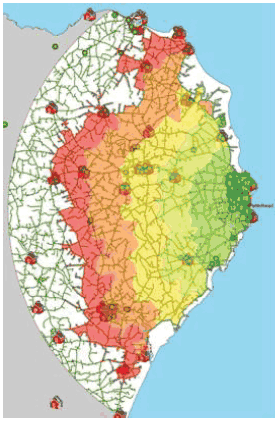
Green Route
All of northern route to Fraserburgh has been removed leaving only the Peterhead urban area.
Blue Route
Completely removed.
Red Route
Completely removed.
Overall
MWth.
Figure 9 Example map to show a higher resolution of the Peterhead map with thresholds applied
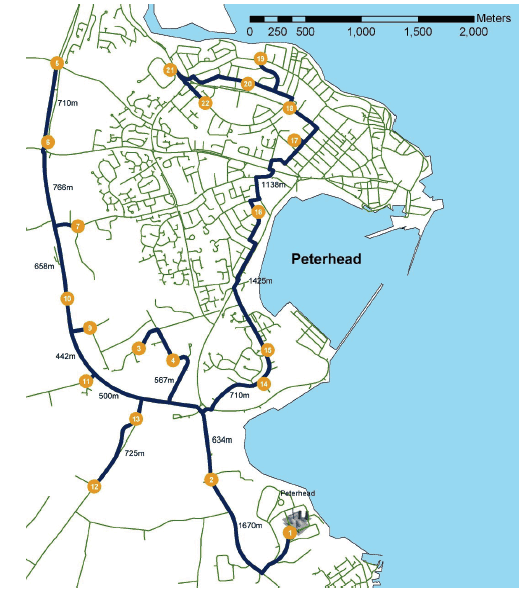
There is a problem
Thanks for your feedback